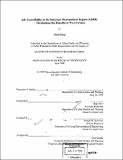| dc.contributor.advisor | Qing Shen and Joseph M. Sussman. | en_US |
| dc.contributor.author | Zhang, Ming, 1963 Apr. 22- | en_US |
| dc.contributor.other | Massachusetts Institute of Technology. Dept. of Urban Studies and Planning. | en_US |
| dc.date.accessioned | 2012-05-15T21:08:08Z | |
| dc.date.available | 2012-05-15T21:08:08Z | |
| dc.date.copyright | 1999 | en_US |
| dc.date.issued | 1999 | en_US |
| dc.identifier.uri | http://hdl.handle.net/1721.1/70741 | |
| dc.description | Thesis (S.M.)--Massachusetts Institute of Technology, Dept. of Urban Studies and Planning, 1999. | en_US |
| dc.description | Includes bibliographical references (p. 115-119). | en_US |
| dc.description.abstract | Public transportation investment is made because of its potential benefits to the society. Properly identifying and measuring these benefits has been the central concern in rail transit decision making. In this research, we focus on the social dimension of rail transit benefits through the Tren Urbano case study. The objectives are: (1) to characterize the social benefits of public transportation, especially rail transit systems, in terms of job accessibility provision; (2) to analyze the distributional effects of the Tren Urbano benefits among geographical locations and social groups in the SJMR; and (3) to examine the effects of supplementary transportation and land use strategies in further enhancing job accessibility in the region. A comparative study method in combining with simple simulations is used for this research. Comparisons of accessibility levels are made between Tren Urbano-Build and No-Build scenarios in 2010, and between 2010 Cases and 1990 Base Case. Policy scenarios are simulated under several assumptions of transportation and land use policies. GIS is utilized to link and process geographical and statistical information, and to visualize the intermediate and final results of analyses. The study results suggest that, through mobility provision, Tren Urbano would contribute to improve job accessibility in the SJMR. All social groups would be better off from the investment comparing to the No-Build alternative. The study also raises concerns that, without additional transportation and land use policies to support Tren Urbano, the benefits of the investment would be quite limited, both geographically and socially. There are both needs and opportunities for policy makers to intervene. From transportation planners' perspective, there are untapped potentials for further improving Publico services. From land use planners' perspective, there are nearly 1200 acres of vacant developable land near Tren Urbano (Phase I) stations. Based on the scenario analysis results, policy recommendations are made aiming to maximize the social and economic returns of Tren Urbano. | en_US |
| dc.description.statementofresponsibility | by Ming Zhang. | en_US |
| dc.format.extent | 144 p. | en_US |
| dc.language.iso | eng | en_US |
| dc.publisher | Massachusetts Institute of Technology | en_US |
| dc.rights | M.I.T. theses are protected by
copyright. They may be viewed from this source for any purpose, but
reproduction or distribution in any format is prohibited without written
permission. See provided URL for inquiries about permission. | en_US |
| dc.rights.uri | http://dspace.mit.edu/handle/1721.1/7582 | en_US |
| dc.subject | Urban Studies and Planning. | en_US |
| dc.title | Job accessibility in the San Juan Metropolitan Region (SJMR) : maximizing the benefits of Tren Urbano | en_US |
| dc.title.alternative | Job accessibility in SJMR : maximizing the benefits of Tren Urbano | en_US |
| dc.type | Thesis | en_US |
| dc.description.degree | S.M. | en_US |
| dc.contributor.department | Massachusetts Institute of Technology. Department of Urban Studies and Planning | |
| dc.identifier.oclc | 50683027 | en_US |
